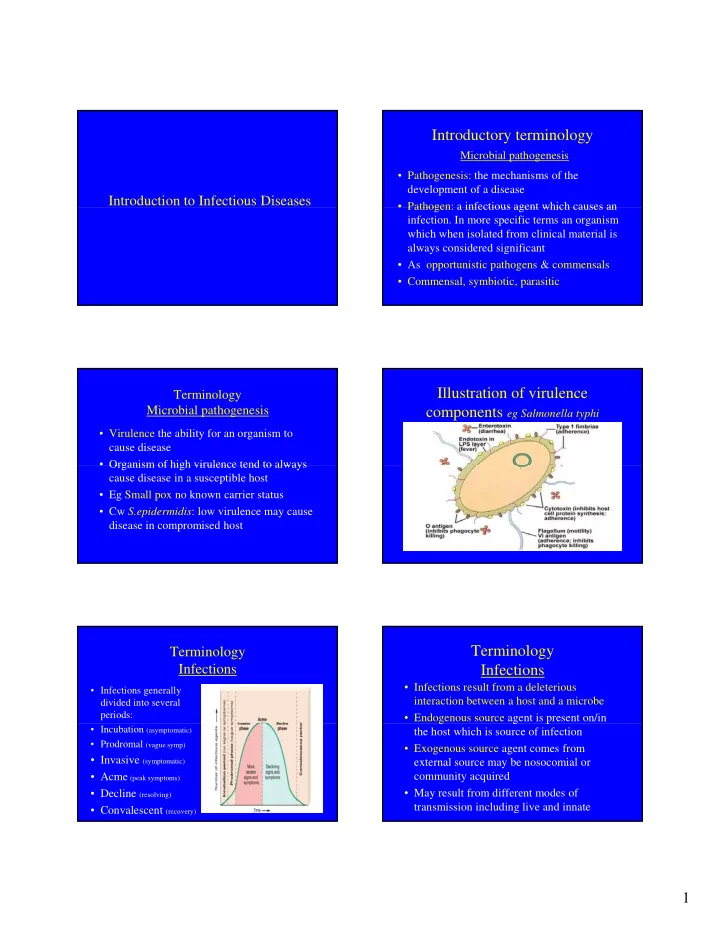

Introductory terminology Microbial pathogenesis • Pathogenesis: the mechanisms of the development of a disease Introduction to Infectious Diseases • Pathogen: a infectious agent which causes an Pathogen: a infectious agent which causes an infection. In more specific terms an organism which when isolated from clinical material is always considered significant • As opportunistic pathogens & commensals • Commensal, symbiotic, parasitic Illustration of virulence Terminology Microbial pathogenesis components eg Salmonella typhi • Virulence the ability for an organism to cause disease • Organism of high virulence tend to always Organism of high virulence tend to always cause disease in a susceptible host • Eg Small pox no known carrier status • Cw S.epidermidis : low virulence may cause disease in compromised host Terminology Terminology Infections Infections • Infections result from a deleterious • Infections generally interaction between a host and a microbe divided into several periods: • Endogenous source agent is present on/in g g p • Incubation (asymptomatic) the host which is source of infection • Prodromal (vague symp) • Exogenous source agent comes from • Invasive (symptomatic) external source may be nosocomial or • Acme (peak symptoms) community acquired • Decline (resolving) • May result from different modes of transmission including live and innate • Convalescent (recovery) 1
Chain of Infection Chain of infection The agent: 1st link Development of an infection is often dependent on a chain of events • Virulence factors include: • Proteases • Infectious dose eg 3CFU for • Collogenases Rickettsia (scrub typhus) cw many • The infectious agent: 1st link • Enterotoxins thousands Salmonella • Virulence factors may determine outcome • Virulence factors may determine outcome • Adhesins • Adhesins • Exotoxins secreted E t i t d of interaction with host (usually multiple factors) factors eg C.diptheriae bacteriocin • Chemotaxis • Intracellular growth • Neurotoxins • Also related to mode of transmission • Haemolysins • Capsules microbes have evolved factors to assist • Avoidance invasion/avoidance of immune system • Endotoxins • Antigenic variation Chain of infection Chain of Infection Transmission: the 2nd link Transmission:the 2nd link • Contact: • Means contact with • 4 recognized routes of sources of infection transmission • Most common is • Contact C t t person:person • Common vehicle • Direct eg HCW with infected • Airborne finger touches wound on patient • Indirect eg Droplet usually • Vector-borne >5µm and travel <1M Chain of infection Chain of infection Transmission: the 2nd link Transmission: the 2nd link • Common vehicle • Airborne transmission spread • Agent is truly airborne • Refers to • Particle size<5µm • Particle size<5µm contamination by • travel >1m inanimate objects • May in droplet nuclei, • Eg Water borne HepA dust particles, skin • Eg HBV by sharing layers needles • Eg Legionella pneumophila 2
Chain of infection Chain of infection Transmission: the 2nd link The host: the 3rd link • Vector borne • Host completes the chain • Eg vaccinated? • Living organism • Mode and site of entry • Immunocompromised? carries agent influence infection rate • Compromised? Eg: p g • Insects most important • Susceptibility issues • Primary viral infection? vector • Broad range antibiotics? • Surgery? • Can be passive eg Flies • Smoking? • Biological vectors • Underlying illness agent may change in • Other ? vector eg Malaria Chain of infection Chain of infection The host: the 3rd link The host: the 3rd link Portals of exit Portals of entry Question: Herd immunity Do vaccinations or level of immunity in a community influence the rate of infections? • The spread of infection is dependent on • In case 1 where few people are immune to several factors including: an infectious disease • The chain of infection aspects which include The chain of infection aspects which include ( (eg 10%) 10%) the susceptible status of the host • The incidence of acute • An observation at the community level is that infections in the level of immunity within a community susceptible hosts is relatively high influences the spread of disease • This phenomenon is termed ‘herd immunity’ 3
Herd immunity Herd immunity • In case 2 where the • In case 3 where the level of immune level of immunity is is persons is eg 50% high eg 90% • The incidence of acute • The incidence of new infections in cases in susceptible susceptible hosts is hosts is very low sporadic and relatively low Herd immunity: summary • Herd immunity then is a concept which suggests that the population may maintain a resistance to an infectious disease because a large proportion of the population is immune to the disease • Eg vaccinated against rubella?, the risk to non vaccinated persons is lower if the general population has a high rate of vaccinates 4
Recommend
More recommend